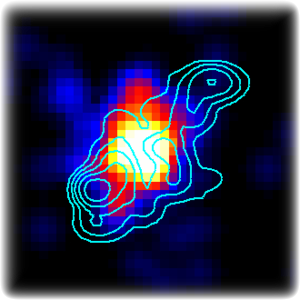 Active Galactic Nuclei (AGN) are for decades the subject of very intense research. As a result, we have today a well-established model of AGN activity. According to it, there is a supermassive black hole in the center of each active galaxy. Matter falling toward the black hole forms an accretion disk around it, where due to process of friction and turbulence loses the angular momentum emitting radiation in the optical, ultraviolet and X-rays. However, despite that intensive studies, active galaxies continue to conceal many mysteries. We do not know for example why only a small portion of them (15-20%) is active in the radio range of the electromagnetic spectrum.
Active Galactic Nuclei (AGN) are for decades the subject of very intense research. As a result, we have today a well-established model of AGN activity. According to it, there is a supermassive black hole in the center of each active galaxy. Matter falling toward the black hole forms an accretion disk around it, where due to process of friction and turbulence loses the angular momentum emitting radiation in the optical, ultraviolet and X-rays. However, despite that intensive studies, active galaxies continue to conceal many mysteries. We do not know for example why only a small portion of them (15-20%) is active in the radio range of the electromagnetic spectrum.
Being a radio-active means a presence of radio jets along the axis of rotation of the accretion disk in these objects. Jets are outflows of relativistic plasma which interacts with the interstellar medium and the magnetic field of the host galaxy and emits radio synchrotron radiation. The plasma finally forms large-scale structures called lobes. These lobes are pushed by the jet away from each other at speeds of a few percent the speed of light, and therefore radio source increases its size even to the order of Megaparsec with age. Linear size of radio source is, therefore, a measure of its age.
In the general scenario of the evolution of powerful radio-loud AGN, the younger and smaller gigahertz-peaked spectrum (GPS, linear size < 1 kpc) and compact steep spectrum (CSS, linear size < 15 kpc ) sources become large scale radio sources with linear size in the order of hundreds of kiloparsecs. We still do not know, however, many details of this process. In particular, we know that there is an excess of compact radio sources relative to the large scale objects. We don’t know however, the reason for this excess and where a part of the compact radio sources then disappears.
Our group, which has been studying the compact radio sources for several years, proposed the hypothesis saying that in the universe there is a very large population of small objects that probably will never be able to develop large-scale radio structures. This means that they will cease their radio activity at the mid-stage of their evolution, as a small source. They were called a short-lived objects. Their radio, optical and X-ray features are significantly different from the features of the so-far known strong radio sources. Detailed results of research of such sources are included in the aforementioned publications.
Group:
Publications:
- Wołowska A., Kunert-Bajraszewska M., Mooley K., Hallinan G. (2017) Changing-look AGNs or short-lived radio sources?, 2017arXiv171200251W
- Kunert-Bajraszewska M. (2016) Dichotomy in the population of young AGN: Optical, radio, and X-ray properties, AN 337, 27
- Kunert-Bajraszewska M., Cegłowski M., Katarzyński K., Roskowiński C. (2015) A VLBI survey of compact broad absorption line quasars with balnicity index BI > 0, A&A 579, 109
- Kunert-Bajraszewska M., Labiano A., Siemiginowska A., Guainazzi M. (2014) First X-ray observations of low-power compact steep spectrum sources, MNRAS 437, 3063
- Kunert-Bajraszewska M., Siemiginowska A., Labiano A. (2013) An X-Ray Cooling-core Cluster Surrounding a Low-power Compact Steep Spectrum Radio Source 1321+045, ApJ 772, 7
- Kunert-Bajraszewska M., Labiano A. (2010) A survey of low-luminosity compact sources and its implication for the evolution of radio-loud active galactic nuclei – II. Optical analysis, MNRAS 408, 2279
- Kunert-Bajraszewska M., Gawroński M. P., Labiano A., Siemiginowska A. (2010) A survey of low-luminosity compact sources and its implication for the evolution of radio-loud active galactic nuclei – I. Radio data, MNRAS 408, 2261

 Piwnice k. Torunia, 87-148 Łysomice
Piwnice k. Torunia, 87-148 Łysomice